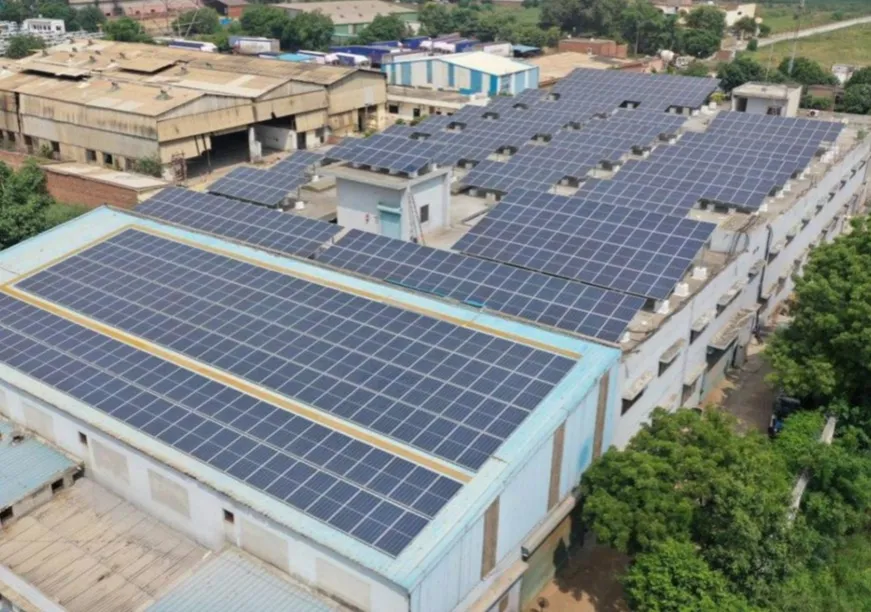
The slow growth of rooftop solar remains a bottleneck in India’s transition to renewable energy. While the central government had set a target of reaching 40GW by 2022, the current installed rooftop capacity stands at less than 15GW—below 20 percent of the total installed solar capacity. This is in sharp contrast with other solarised nations like Germany, Australia, and the United States (US), where rooftop installations nearly match their utility-scale counterparts.
Commercial and Industrial (C&I) power consumers are currently responsible for around 80 percent of rooftop installation—driven primarily by large firms. Micro, small, and medium enterprises (MSMEs), which account for around 30 percent of India’s gross value added, have seen very limited adoption. Given that there are around 63 million MSMEs in India, contributing to 30 percent of the industrial energy demand, it is imperative to swiftly prioritise rooftop solar adoption in this sector as a central policy objective.
Commercial and Industrial (C&I) power consumers are currently responsible for around 80 percent of rooftop installation—driven primarily by large firms.
MSME’s power consumption patterns are likely to be well-suited for rooftop adoption. Moreover, they also stand to realise substantial economic gains by embracing these technologies. These insights have been highlighted in a recent survey of around 6,500 industrial power consumers conducted by the Observer Research Foundation (ORF). First, the share of electricity cost in total operational cost (between 5-20 percent) is higher for MSMEs compared to larger firms across different industrial segments. Thus, a shift to rooftop solar could be an important means of reducing production costs by reducing expenditure on grid electricity and selling additional units back to the utilities.
Second, MSMSE in the manufacturing sector predominantly utilises electricity during daylight hours when ample sunlight is accessible. According to the ORF study, approximately 75 percent of MSME electricity consumption is concentrated between 9 am and 4 pm. Rooftop solar could, therefore, effectively cater to their electricity demand without much change in operational patterns and without the necessity for substantial investments in expensive battery storage systems.
Finally, power cuts continue to hamper the MSME’s operations, compelling many of these enterprises to resort to diesel generators for backup power. This reliance not only contributes to air pollution but also results in escalated operational expenses. Considering that the highest frequency of power cuts is reported during daylight hours—rooftop solar holds great potential to reduce the reliance on DG set. This would benefit MSMEs by enhancing both the reliability and affordability of power.
Rooftop solar could, therefore, effectively cater to their electricity demand without much change in operational patterns and without the necessity for substantial investments in expensive battery storage systems.
Although the argument in favour of MSME rooftop adoption is compelling, shifting to renewable energy remains a low priority for these firms. MSMEs have limited capacity and resources to assess both the technical and economic feasibility of replacing grid electricity with rooftop solar. As a result, there is a common perception that rooftop solar is not cost-effective given the high initial investment. This is despite substantial evidence which suggests that in the long run, rooftop solar emerges as a more economical choice compared to grid electricity since once initial costs are covered, the marginal cost of utilising additional electricity is negligible. The low interest from MSMEs is further exacerbated by a lack of awareness regarding the regulatory requirements for rooftop solar and net metering.
The biggest challenge for MSMEs, however, continues to be the difficulty with financing. Many of these firms are not part of the formal economy and tend to have poor credit-worthiness and highly leveraged borrowing structures. Thus, financial institutions are unwilling to lend to them or only provide loans at higher interest rates. Developers are also cautious in extending operational cost-based (OPEX) adoption models to these entities which allow consumers to spread out the high upfront cost of rooftop solar over the lifetime of the product. Identifying targeted financial instruments for the MSMEs will be the key facilitator for greater adoption in this segment.
The low interest from MSMEs is further exacerbated by a lack of awareness regarding the regulatory requirements for rooftop solar and net metering.
These issues will not be resolved on their own or simply with time. MSMEs will require targeted support to create the right conditions for rooftop adoption. Currently, subsidies for rooftop solar are only provided to residential consumers. While it may not be feasible to extend subsidies to all C&I consumers, there is a pressing need to provide some form of economic incentives for MSMEs to adopt rooftop solar. For example, the subsidies under the National Solar Rooftop Scheme can be extended to C&I consumers only with connected load up to a certain level, this can ensure that subsidies are picked up by the smaller firms which face the biggest challenges for adopting rooftop solar.
There is also a need to create successful examples of MSME rooftop solar adoption that can illustrate how these enterprises can overcome both technical and financial obstacles. A cluster-based approach could prove useful in this regard. India has around 400 industrial MSME clusters which gather firms operating within a particular sector in a single location. A national cluster-based MSME rooftop solar programme could be implemented in 10-20 clusters covering industries that may be best suited for rooftop adoption. A similar programme has already been implemented with substantial success by the Bureau of Energy Efficiency (BEE) to improve energy efficiency.
The cluster-based programme could focus on three areas in particular: i) Piloting projects and capacity-building initiatives which can help MSMEs identify the right rooftop solar technologies and asses financial implications based on their operational patterns; ii) aggregating demand for solar developers and providing financial guarantees through either the discoms or state government to extend the OPEX-based business models to these entities; and iii) Helping build credit worthiness of MSMEs and connecting industrial units to international financial institutions and national development banks which can provide low-interest loans specifically for rooftop solar.
A national cluster-based MSME rooftop solar programme could be implemented in 10-20 clusters covering industries that may be best suited for rooftop adoption.
Prime Minister Modi's recent announcement of the Pradhanmantri Suryoday Yojana (PSY) aiming to install rooftop solar in 10 million households has sparked enthusiasm among companies, consumers, and investors for residential solar adoption. A similar scheme is now needed to invigorate MSMEs to adopt rooftop solar and ensure that the backbone of the Indian economy can harness the benefits of solar energy.
Promit Mookherjee is an Associate Fellow at the Observer Research Foundation
The views expressed above belong to the author(s). ORF research and analyses now available on Telegram! Click here to access our curated content — blogs, longforms and interviews.




 PREV
PREV


